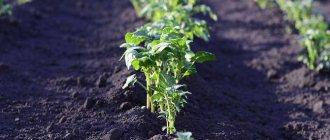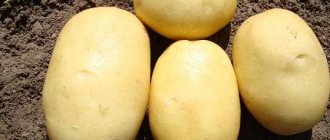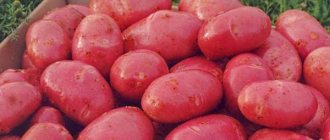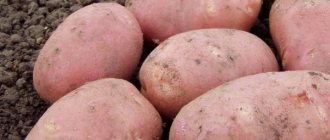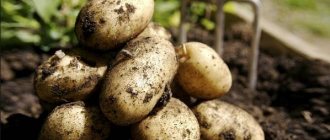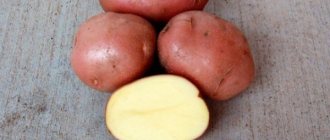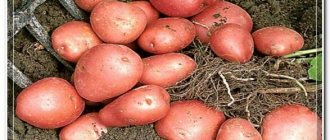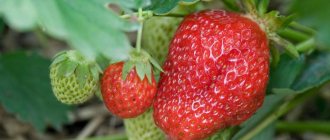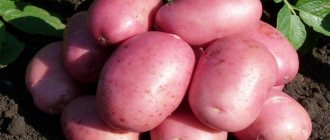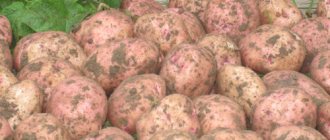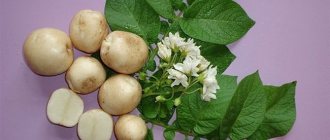Description of the variety
The creation of breeders from Germany is a universal variety that has proven itself to be the best and was bred for cultivation in unfavorable climatic conditions. It has high consumer qualities. The originator of the variety is the German company Solana. This potato is loved by ordinary vegetable growers and not only. It is Queen Anne who is grown at the residence of the President of Belarus. The variety was successfully tested in the Middle Volga region of Russia and included in the State Register in 2015.
The external distinctive features of Queen Anne potatoes are as follows:
- The tubers are smooth and yellow. They have an elongated oval shape.
- The fruits are resistant to glandular and black spotting and mechanical damage. They keep well.
- The pulp is cream or yellow, firm. It does not fall apart during cooking and does not darken.
- The peel is dense and smooth, has small superficial eyes. Housewives really like this characteristic - peeling such potatoes is a pleasure.
- Potato shoots are spreading. The number of fruits on one bush is from 6 to 16.
- Queen Anne bushes are low, stem type, semi-erect or erect.
- The leaves are large, have a small fluff and a rich dark green color.
- The petals of the inflorescences are white, they densely cover the shoots.
Photo
We invite you to visually familiarize yourself with the Queen Anne potatoes - a noble species, the variety description of which is outlined above in the photo we offered:
Characteristics and Features
Koroleva Anna is a mid-early universal variety (in terms of the degree of digestibility it belongs to type B), one of the highest yielding among this vegetable crop. A large number of fruits develop on one bush, ensuring high yields. It exceeds the standards of the Middle Volga region, where the first samples were made. On the 45th day after germination, 100 centners per hectare were collected.
The general characteristics of the variety are as follows:
| Characteristic | Magnitude |
| Productivity average/maximum | 395/500 c/ha |
| Maturation period | 80-85 days (mid-season) |
| Weight of one tuber | 85-100 g |
| Starch content | 13-15% |
| Product marketability | up to 94% |
| Harvest keeping quality | 93% (up to 97%) |
Large neat tubers can reach a length of 10 cm or more. Queen Anne is characterized by high marketability - no less than 82%. Most tubers are suitable for sale. Root vegetables are easy to wash, convenient to transport and store. They lie until spring if storage standards are observed. Vegetable growers praise Queen Anne for its keeping quality.
The taste of the fruits is good; due to their texture, they do not become soft during heat treatment. The percentage of starch content varies depending on the growing weather conditions:
- in dry, hot summers there is more starch - up to 15%;
- in cloudy, rainy summers the concentration of the substance is lower - about 13%.
Fertilizers also affect the level of starch and prevent it from decreasing. Indicators may affect the quality of dishes prepared from potatoes. If the starch content is less than 14%, the fruits make delicious salads, soups, and purees. With a higher concentration of the substance, potatoes are ideal for frying. You can make homemade chips from these potatoes.
The Queen Anna variety has exceptional resistance to a number of common diseases and pests:
| Diseases | Degree of stability | Rating (on a 10-point scale) |
| Potato cancer (D1) | immunity | 10 |
| Golden cyst nematode (Ro1, Ro4) | immunity | 10 |
| Common and silver scab | high | 10 |
| Rhizoctoniosis | very high | 9 |
| Black spot | very high | 9 |
| Wrinkled streak mosaic and leaf roll viruses (Y, Y-ntn) | very high | 9 |
| Blackleg | very high | 9-8 |
| Iron spot | high | 8 |
| Late blight of tubers | high | 8 |
| Late blight of tops | medium to high | 8-7 |
Features of agricultural technology of the variety
Basic growing techniques are standard:
- preparation for landing;
- landing;
- harrowing, loosening;
- watering (if necessary);
- fertilizing (if necessary);
- hilling;
- preventive spraying against pests and diseases.
Future productivity largely depends on proper preparation of tubers and care, so these measures are carried out especially carefully.
Preparing potatoes for planting
Potato sorting is carried out in the fall, selecting medium-sized tubers. About 2-3 weeks before planting, take the seeds out of the cellar, place them in boxes or scatter them on the floor or flooring in a layer of 10-15 cm.
It is recommended to spread it in a well-lit place, maintaining a temperature of approximately +13ºC…15ºC.
On a note! If the temperature is too high and there is no light, the sprouts will be long, elongated, and weakened.
Properly germinated tubers have thick, stocky sprouts, approximately 2-2.5 cm. It is advisable to disinfect the seed material in a solution of boric acid or a pink solution of potassium permanganate. This variety is resistant to a number of diseases, but prevention will not be superfluous.
Site selection
Despite the fact that the Queen Anna variety is unpretentious, fertile, well-lit areas are selected for cultivation. Areas not suitable for planting:
- lowland;
- swampy;
- shaded (near buildings, solid fences and fences).
The beds are prepared in the fall, organic matter is added, and they are dug up. This variety responds well to the addition of ash. On acidic soils, it is necessary to add dolomite flour and fluff lime. Fresh manure cannot be applied to potatoes, only rotted compost.
Planting potatoes
Planting time is determined by the weather and soil warming. Typically, soil temperatures of +14ºC…+15ºC are considered suitable for potatoes.
Planted under a shovel, having previously made grooves or in separate holes.
On loam, the depth of the holes is 10-12 cm; on light soils, 8-10 cm is enough. Ash and compost are used as top dressing (pour into furrows or holes). When planting, make sure that the sprouts are not damaged or break off.
Loosening
Potatoes produce their first shoots in about 12-15 days. During this period, the soil is loosened with a rake, removing quickly emerging weeds.
When loosening, the soil is saturated with oxygen, large clods of earth are crushed (especially if there is no rain at that time). Experienced gardeners then carefully loosen the ridges after precipitation until the bushes close together.
Watering
The variety is considered drought-resistant, but a prolonged lack of moisture is detrimental to plants. Overmoistening of the soil is also dangerous, so a “golden” mean is observed.
Reference points - weather conditions, soil moisture indicators, plant condition. If there is no drought, then rain is enough for potatoes. In hot summers, water 3-4 times:
- 8-10 days after planting;
- at the stage of bud formation;
- immediately after flowering.
In rainy summers, the crop does not need watering; there is enough moisture from heaven. But at the same time, they monitor the soil, preventing it from becoming waterlogged and rotting the tubers.
On a note! Water the potato beds along the furrows with heated water. It is advisable to water in the morning, before the onset of summer heat.
Feeding
Typically, summer residents plant potatoes in pre-fertilized beds. But additional fertilizer applications (according to the norm) for this productive variety will not be superfluous.
Approximate diagram:
- 30-40 days after planting the tubers, the potatoes are fed with urea;
- at the stage of bud formation and flowering, it is useful to add organic matter;
- after flowering, potassium sulfate and ash are added.
Fertilizing is required on poor and infertile soils.
Hilling
When planting in ridges, the top layer is slightly loosened. Hilling up potatoes increases the number of side shoots on which tubers are formed. This helps to increase overall productivity.
If Queen Anne potatoes are covered with a ridge at the time of planting, loosen the top layer. Hoes and hoes are used for hilling. The Queen Anna variety is cultivated in vegetable farms using mini-tractors or motor cultivators.
Main events:
- first hilling - plant height reaches 10-15 cm. Hill up from all sides of the bush, up to the top leaves;
- They spud the second time after about 10-14 days, when buds appear on the bushes.
The procedure is repeated according to the same scheme after 2 weeks. This technique gets rid of weeds and prevents the bushes from falling apart.
Some summer residents, if they have time, hill up potatoes three times, but for this variety two procedures are quite enough.
Hilling is carried out only on wet and loose ridges, preferably in the morning or evening. In the south, during prolonged droughts, hilling is often not carried out to preserve moisture in the soil.
Diseases and pests: how to fight
The Queen Anna variety is not susceptible to infections, but is not completely immune from diseases. There are cases of late blight and the appearance of some other fungal infections. Shows high resistance to diseases:
- scab;
- cancer;
- rhizoctoniasis;
- striped mosaic.
Of the pests, the Colorado potato beetle is the most dangerous. Prevention:
- pre-planting treatment of tubers (preparations Maxim, Prestige);
- spraying beds with plantings before flowering (preparations Stozhar, Aktara).
It is necessary to regularly inspect the crops and, when larvae or beetles appear, collect them manually. Baits for the Colorado potato beetle made from potato tubers are effective.
Among the folk remedies used for processing:
- infusion of onion peel;
- horsetail infusion;
- infusion of birch tar.
Pros and cons of growing
For the sake of its undoubted advantages, Queen Anne is grown by gardeners on their plots. The tubers germinate well and quickly, even with the onset of frost, and set together. The fruits gain strength and are ready for consumption after the first digging; there are practically no small specimens.
Potato growers who grow Anna for sale note its external advantages: all the fruits are conveniently shaped, aligned, transport well, are resistant to minor damage and last a long time.
When developing this potato variety, German agronomists tried to take into account many nuances and brought the best to their brainchild. Therefore, Queen Anne has much more strengths than weaknesses, but there are still disadvantages.
| Advantages of the variety | Disadvantages of the variety |
| taste qualities | average drought resistance |
| resistance to pests | requirement for watering |
| high yield | defeat by single diseases |
| good germination | |
| neat looking tubers |
Advantages and disadvantages
There are some disadvantages, but not many:
- Queen Anne, despite her high immunity, is not protected from all fungal diseases.
- Potatoes do not tolerate drought well and need constant watering.
Speaking of advantages, the list is much longer:
- It has high productivity.
- The potatoes are large, ideally shaped, making them easy to sell on the market.
- The eyes are superficial, making it very easy to peel root vegetables.
- Potatoes have excellent taste.
- The fruits contain a large amount of carotene.
- Not afraid of long-term transportation and resistant to mechanical damage.
- Queen Anne is not picky about the type of soil.
- Not demanding on storage conditions.
How to grow and care for potatoes?
Planting and caring for German potatoes takes place in the traditional manner, not much different from the agricultural practices of other varieties. The only thing that a noble variety may require is additional moisture, and only in those places where the soil is too dry and there is little rainfall. In dry regions, potatoes require more frequent and abundant watering.
The variety is suitable for almost any soil in any corner of Russia. It can be grown on large plantations and small plots of land.
German breeders adapted the variety to unfavorable conditions and difficult climate.
Place and timing of landing
With the right approach, planting Queen Anne tubers is carried out only in warm, slightly moist soil. This is a guarantee of a good harvest. Like other early varieties, you can germinate potatoes starting in April, planting the first tubers in the ground in mid-May.
Too high or low temperatures affect fruit germination. And if the soil is not dry enough, it will make it difficult for oxygen to reach the tubers. The weather for landing should be as follows:
- soil at a depth of 10 cm - about 10 degrees;
- air - at least 11 degrees.
When choosing a place for garden beds, it is important to take into account such parameters as lighting, protection from strong winds, and the absence of lowlands where moisture will accumulate. Ideally, the planting ridges are located from north to south, which will provide them with good heating. The quality of the soil is not important, Queen Anne can grow anywhere, but still (for high yields) it prefers light, neutral acidity and loose soils:
- peat;
- black soil;
- sandy loam;
- loams.
The potassium content should be high. The soil can always be improved: add sawdust or sand to loamy soil, rich soil to sandy soil, and lime to acidic soil. It is not recommended to plant potatoes in the same area for several years in a row. You can return to the garden beds only after 3 years. In addition, you should not plant this crop next to nightshades.
We extinguish acidic soil with lime
The predecessors of potatoes in the selected area can be:
- roots;
- cruciferous;
- onion crops;
- pumpkin
Soil preparation
It is necessary to prepare the soil for planting potatoes in the fall. The first thing you need to do is dig the soil deeply and get rid of the weeds. If necessary, organic fertilizers are added in the form of ash. For 1 sq. m requires 0.5 kg of ash and 1 bucket of compost. You can also use mineral fertilizers: superphosphate, urea, potassium nitrate.
In the spring, the land will undergo additional cultivation. The beds are leveled, furrows are cut in the soil or holes are made. At this point, it is advisable to fertilize the soil with fertilizers containing nitrogen. A remedy for pests and diseases is added to the finished dug holes (holes or furrows). The soil is very moist.
Since the variety develops many tubers, large distances are required between holes - at least 20-40 cm both in rows and between rows. This is necessary for proper nutrition of each bush.
Potatoes Queen Anne - planting
Planting begins in mid-May, after waiting until the soil warms up to +13+150 C, and there is no danger of new frosts. For the future harvest, you need Queen Anne seed potatoes of small size. The tubers are not cut. It is recommended to carefully inspect each potato - the planting material must be of high quality, free from damage, viruses and insects. Potatoes selected for beds must be treated with boric acid, Maxim or Prestige preparations. This is done to kill germs. Then the tubers are placed in a dark place to dry. Germination is carried out:
- in special plastic bags;
- in boxes;
- scattered on the floor.
During the germination of tubers, sunlight should be avoided. The sprouts should be greenish and strong. When planting Queen Anne potatoes, you should follow the plan. The distance in the beds between future bushes should be 25-30 cm, between the rows - 65-70 cm. It is recommended to place the beds in the direction from north to south so that the sun's rays fall evenly on the plant.
One tuber is lowered into the hole. If there are more, they will interfere with each other. The harvest will be abundant, but the potatoes will grow small. As soon as planting is complete, the potatoes are covered with soil and mulched with peat, sawdust or dry grass. Mulch will not allow weeds to become active in the area.
Preparation of planting material
A week before planting potatoes in the ground, you should carefully prepare the seed. All tubers must be sorted out, small root crops that have rotted and spoiled, for example, by mice, must be discarded. The rest are left for a few more days in a warm place.
Queen Anne reacts positively to sunlight. In direct sunlight the fruits turn slightly green. Corned beef accumulates in them - a harmful substance, which makes such potatoes unsuitable for food, but they sprout well.
With the appearance of the first sprouts, the tubers can be placed in the holes, having previously treated them with a growth stimulator (optional). Fruits for planting should be:
- whole;
- medium size (too large ones are divided in two, although this is undesirable);
- healthy.
In order to start biochemical processes, the tubers need to be warmed up. This is done 45-60 days before the expected planting of root crops in the ground. This process is divided into two stages: dry and wet heating. The first is carried out at a high temperature of 28-30 degrees for 4-5 days, then the temperature is reduced to 15 degrees, placed in boxes with wet sawdust. There is an active growth of strong young shoots and rudiments of the root system. After a month of such storage, the root crops are completely ready for planting.
Step by step planting guide
After cultivating a plot of land for planting and tubers, the seed material is planted in the ground.
Standard scheme:
- Markings are made on the site. They start by determining the distance between the rows. Then a string is pulled on as a guide and the location for the first furrow is marked.
- When planting root crops, it is important to maintain the distance between them and leave sufficient distance (60-70 cm) between the rows for ease of hilling.
- In the furrows, recesses are made for planting - not too large, but not small. Optimally – 15-20 cm. The size of the potatoes affects the depth of the hole: the smaller they are, the closer they “sit” to the surface.
- Only one root crop is placed in each hole. If there are more of them, there will not be enough space for the tied tubers, and the harvest will be small.
- Bury the holes immediately to prevent the potatoes from becoming airy.
- The Queen Anna variety is useful to fertilize. Immediately after planting the tubers in the ground, you can sprinkle the beds with a thin (2-3 cm) layer of peat.
Pests and diseases
Queen Anne is characterized by high resistance to most diseases of nightshade crops. The main problem during cultivation is the defeat of the aerial parts and tubers by late blight. For preventive purposes, potatoes are treated with Bordeaux mixture in the spring. At the first signs of a fungal infection, Penncozeb is used.
Rhizoctonia blight is less commonly observed on the plant. The disease manifests itself as black spots on the tops and tubers. Such potatoes cannot be stored. If a problem is detected, spray with Vitavax 200. Of the pests on the Queen Anna variety, only the Colorado potato beetle parasitizes. Insects are collected by hand, and the bushes are treated with the drug “Tiran”. The event is relevant before and during flowering.
Watering, hilling, fertilizing and weeding potatoes
Characteristics of the variety involve carrying out such agrotechnical practices as: regular watering, hilling and loosening, weeding, picking off flowers on shoots to form tubers, treatment against parasites and diseases, and other manipulations.
If you reduce the number of flowers on the bushes - cut them off - more tubers will form.
The recommendations are standard, but experienced vegetable growers advise paying close attention to regular procedures, especially watering. The variety has average resistance to heat and drought. Planting in the southern regions of the country requires special attention.
The rules are as follows:
- Watering the beds begins from the moment the tubers form, i.e., in the phase of formation of buds on the bushes. This is the most important period - from the moment the first buds appear until the tops stop growing.
- The beds should be watered at least once a week.
- The ideal system is a spray system, this avoids erosion of the roots.
- Soil moisture in the beds should be uniform.
- It is advisable to water potatoes in the evening. It is strictly not recommended to do this in hot weather.
- The optimal amount of water per bush is 3 liters.
- The next day after watering, the soil is loosened. This way the moisture will stay in it.
Gardeners pay a lot of attention to loosening the soil and hilling up bushes. The soil must be enriched with oxygen, and this can be achieved through regular digging. In addition, this way the roots are saturated with moisture and receive all the necessary microelements.
Queen Anne is unpretentious, but hilling the beds must be very gentle, since the roots of the potatoes lie close to the surface. They can dry out in the heat, so manipulation should be regular.
Organic and mineral substances are suitable as fertilizer for Queen Anne. Wood ash, manure, bird droppings, ammonium and potassium nitrate, complex fertilizers, etc. are optimal. Fertilizing is alternated with watering. Fertilizers for the variety need to be applied three times throughout the season:
- The first is during the period of stem growth.
- Repeated - before flowering.
- The third is after flowering.
Productivity
This variety is a high-yielding potato. From one hectare you can get up to 55 tons . In vegetable gardens, if you follow the rules of planting, weeding, and hilling, you can get 2.5 kg from each bush.
The harvest begins 70 days after planting, at the moment when the leaves begin to turn yellow and the flowers fall off.
The property of German selection is the Red Lady potato variety
Read
Potato variety of domestic selection - Tuleevsky
Read
Methods of controlling diseases and pests
Queen Anne is quite resistant to the main diseases and dangerous pests inherent in this crop: potato cancer, nematode, late blight of shoots and tubers, wrinkled striped mosaic, leaf curl. Natural defense is good, but it can be improved. So, during the growing season, potato bushes must be treated with fungicides that protect plants from insects. Preventive spraying is carried out in dry weather.
Tomatoes and peppers have diseases in common with potatoes. In addition, they attract the same parasites. Planting them next to each other is a risk.
During the growth process, potatoes undergo processing. It is important to constantly monitor the presence of parasites on the bushes: Colorado potato beetles, beetle larvae, mole crickets, potato moths and others. If the disease is detected at an early stage, emergency measures are taken - collecting parasites and spraying. For prevention purposes, it is recommended to disinfect plants in advance with such preparations as:
- "Anti-bug";
- "On the spot";
- "Bankol";
- "Bi-58 New";
- "Decis".
Vegetable growers should take into account that all work with chemicals must be carried out on time: no later than 2 weeks before the first harvest.
In order not to create favorable conditions for the appearance and reproduction of harmful insects, it is necessary to loosen the soil and pull out weeds in advance.
Standards of care
We recommend reading our other articles
- Cherry variety Malyshka
- The best beef breeds of bulls
- Garlic Rocambole
- Picking eggplant seedlings
The harvested crop can be used for sale and storage
The main requirement of Queen Anne potatoes is that there are no sudden temperature changes. This negative factor can delay the development of the bush and tubers. But otherwise the standards of care are the same as in the case of other varieties.
- Watering can be carried out between rows or by irrigation method. They do not water often, some gardeners do it only 3 times: after the sprouts appear, when the first flowers appear and after flowering ends. But if the soil dries out too much, then you need to water more often, since Queen Anne potatoes do not tolerate drought.
- Feeding is necessary, first of all, during the growth of the tops. At this time, nitrogen fertilizers are mainly used. If the leaves begin to curl and turn light green, then it is necessary to feed the crop with phosphorus. If the foliage has become narrow and pale, then potassium is added.
Important!
It is recommended to pick off the emerging flower stalks. To do this, put on gloves and pick off the flower stalks one by one. And in order not to introduce infection into the plant, it is necessary to periodically rinse the gloves in a solution of potassium permanganate.
- Loosening and weeding are needed several times a season. The soil under the bushes should not crust over, much less crack! To prevent this from happening, it is worth loosening the row spacing and weeding the area under the bush approximately once every 1-2 weeks.
- Hilling is done 2 times in this case. The first time this is necessary when the tops have grown by 20 cm, and the second time after another 2-3 weeks.
- 1-2 weeks before harvesting, the tops are cut off so that small stumps remain. From the stumps you will be able to figure out where to dig, and due to the fact that the tops are cut, the plant will be able to transfer all the nutrients to the tubers and the harvested potatoes will be more useful than if the tops are not cut.
The harvested crop can be used for sale and storage. The storage location should be dry and dark, it should be cool, but not very cold - at sub-zero temperatures the potatoes will freeze. Under proper conditions, the tubers are perfectly stored until April-May.
Harvesting and storage
Queen Anna is an early ripening variety. 70 days after the first shoots, technical maturity begins. You should not overexpose ripened root crops in the beds. After the potato bush has completely yellowed and dried, you can harvest. By this time, the tubers will have reached the size and weight characteristic of this variety. Conditional maturity will occur - when the fruits have gained strength, but the peel is still thin and lags behind the tuber.
Before digging up potatoes, it is recommended to mow the tops. This will make the process easier and more. If you do this manipulation in advance - about a week before the expected digging of the potatoes - the peel will become denser and rougher, which will ensure longer storage of the harvested crop.
Queen Anna is an early ripening variety, but it is stored well and can last for several months without losing its consumer qualities if all conditions are met. A dry, dark place is suitable for storage.
Potatoes need:
- low positive temperatures;
- humidity not less than 70%.
Read more about proper storage of potatoes here.
Reviews from vegetable growers
The German Queen Anne potatoes have managed to please many vegetable growers and gardeners. Mostly positive reviews are left about it:
★★★★★
Marina, Poltava. We plant Queen Anne along with other varieties, and among them it is the undisputed leader.
The bushes grow very quickly and do not require special care. We water them only in dry times and hill them twice a season. The harvest is excellent: from each bush there are 15-20 tubers, all even, large, smooth. They are well stored and do not rot. I like the taste of potatoes: their texture is tender and uniform, and they don’t fall apart when cooked. It is better to boil the young ones, and fry the ripe ones. ★★★★★
Ravil, rep. Tatarstan. In our family we constantly grow potatoes and keep track of new vegetable growing products.
Queen Anne made the best impression of all! Only 1.5 months pass after planting, and you can already harvest young potatoes. Root vegetables are uniform in size, have smooth skin and are easy to peel. One year they decided to leave the potatoes for storage - Queen Anne successfully remained until spring. We managed to get good seed material and continue planting next year. ★★★★★
Ekaterina, Moscow region, summer resident. I have been planting the Queen Anna variety for several years.
It so happened that the area that was prepared for her was painful. But I treated the ground in advance with a saturated pink solution of potassium permanganate and thoroughly sprayed the soil with it, especially in the dug holes. To increase the yield, I used organic and mineral fertilizers: mullein and bird droppings, nitrogen. The result exceeded expectations. Queen Anne is a wonderful variety! Hide
Add your review
The brainchild of German breeders - the early ripening potato variety Queen Anna - is successfully grown in our country, meeting the high requirements of vegetable growers. It takes root and bears fruit in any area in any year, although in lean years - rainy and cold - some gardeners complain about a deterioration in taste. The quality of potatoes is reflected in the balance of nutrients. With proper care, the variety will thank gardeners with a rich harvest.
0
0
Copy link
